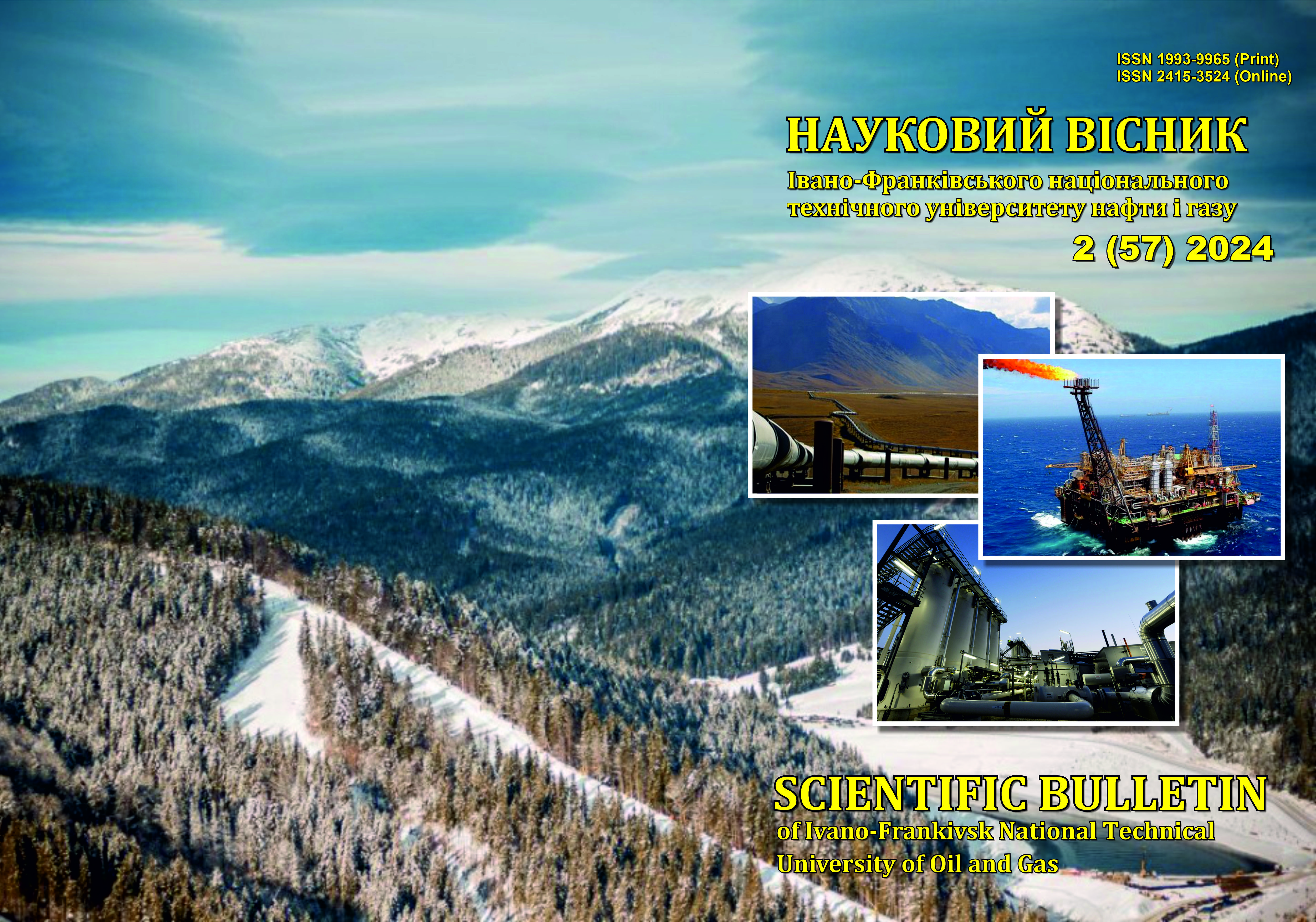MODELING OF THE WORKING PROCESS OF AN OVER-CHISEL SHOCK-EJECTION DEVICE
DOI:
https://doi.org/10.31471/1993-9965-2024-2(57)-42-49Keywords:
ejection system, downhole jet pump, shock device, injection coefficient, pressure characteristics, electrohydrodynamic analogyAbstract
The algorithm for determining the hydraulic characteristics was developed and the working process of the author's proposed design of the shock-ejection device designed to increase the efficiency of drilling wells in conditions of increased rock strength was developed. The developed over-chisel arrangement consists of a parallel impact device in the form of a ball vibrator and a jet pump in the form of an injection-suction type ejection system. The impact device increases the efficiency of rock destruction, and the jet pump intensifies the process of washing the hole. The hydraulic calculation of the working process of the superchisel impact-ejection assembly is based on the application of the method of electrohydrodynamic analogies supplemented by the equations of the characteristics of the jet pump. The hydraulic model of the working process of the shock-ejection assembly involves the solution of the system of cost balance equations for the nodal points of the ejection system, head losses in parallel links of the closed suction circuit of the circulation of the flushing solution, and the analytical expression that determines the pressure-cost characteristic of the jet pump. In the process of determining the hydraulic losses in separate parallel links of the suction circuit, classical relations were used to calculate the hydraulic losses in local resistances and the empirical dependence of the coefficient of hydraulic resistance of the ball vibrator on the Reynolds number of the flushing solution flow. The proposed hydraulic model of the working process of the shock-ejection device made it possible to determine the nature of the distribution of flows in the hydraulic system of the well layout. According to the obtained results, the maximum flow of the flushing solution is directed to the
Downloads
References
Sapińska-Śliwa A., Wiśniowski R., Korzec M., Gajdosz A. Rotary – percussion drilling method - historical review and current possibilities of application. AGH Drilling Oil Gas. 2015. Vol. 32(2). Р. 313–323. https://doi.org/10.7494/drill.2015.32.2.313. [in Poland]
Śliwa T., Korzec M., Jaszczur M., Sapiń-ska-Śliwa A., Gajdosz A., Kruszewski M.A. Possible application of rotary-percussion drilling method in shale gas wells in the Podlasie Basin region. Technika Poszukiwań Geologicznych Geotermia, Zrównoważony Rozwój. 2018. No. 2. Р. 197–222. URL: https://min-pan.krakow.pl/wydawnictwo/wp-content/uploads/sites/4/2018/10/14-sliwa-i-inni.pdf. [in Poland]
Terentiev O.M., Gontar P.A. Implementation of the combined method of rock destruction with explosive-mechanical means. Theoretical & Applied Science. 2014. No 4 (12). P. 44–48. https://doi.org/10.15863/TAS.2014.04.12.8.
Liu H., Wang G., Yang C., Zhang J., Chen S. Rock strength weakening subject to principal stress rotation: Experimental and numerical investigations. Journal of Rock Mechanics and Geotechnical Engineering. 2024. Vol. 16. Iss. 9. P. 3544–3557. https://doi.org/10.1016/j.jrmge.2024.04.004.
Xuan L., Guan Z., Hu H. Analysis and Improvement of the Rotary Percussion Drilling Tool in Oil Wells. Atlantis Press: Proceedings of the international Symposium on Material, Energy and Environment Engineering (ISM3E 2015), Changsha, China on November 28-29, 2015. Р. 510–513. https://doi.org/10.2991/ism3e-15.2015.122.
Tu Y., Li B., Zhan G., Aljohar A. Application Study on 4 3 4-inch Rotary Percussion Drilling Tool in Hard. Proceedings of the International Petroleum Technology Conference, Dhahran, Saudi Arabia, 12 February 2024. Paper Number: IPTC-23921-EA. 4 р. https://doi.org/10.2523/IPTC-23921-EA.
Xuan L., Guan Z., Hu H. Design and Analysis of a Novel Rotary Percussion Drilling Tool in Petroleum Exploration. Journal of Applied Science and Engineering. 2017. Vol. 20. No. 1. P. 73–80. https://doi.org/10.6180/jase.2017.20.1.09.
Xi Y., Wang H.-Y., Zha C.-Q., Jun L., Liu G.-H., Guo B.-Y. Numerical simulation of rock-breaking and influence laws of dynamic load parameters during axial-torsional coupled impact drilling with a single PDC cutter. Petroleum Science. 2023. Vol. 20. Iss. 3. P. 1806–1827. https://doi.org/10.1016/j.petsci.2023.01.009.
Wang W., Liu G., Li J., Zha C., Wei L. Numerical simulation study on rock-breaking process and mechanism of compound impact drilling. Energy Reports. 2021. Vol. 7. P. 3137–3148. https://doi.org/10.1016/j.egyr.2021.05.040.
Minnivaleev T.N., Kuleshova L.S., Arslanov I.G., Gizzatullina A.A., Minnivaleev A.N. Influence of shock-vibration loads of drilling equipment on the drilling indicators of oil and gas wells. Journal of Physics: High-tech and Innovations in Research and Manufacturing – HIRM 2021 (Conference Series). 2022. Vol. 2176(1). Р. 1–10. https://doi.org/10.1088/1742-6596/2176/1/012025.
Panevnyk O.V. Teoretychni osnovy pobudovy uzahalnenykh hidravlichnykh modelei sverdlovynnykh strumynnykh nasosiv: dys. ... doktora tekhn. nauk : 05.05.12 / Panevnyk Oleksandr Vasylovych. Ivano-Frankivsk, 2000. 359 p. [in Ukrainian]
Kryzhanivskyi E.I., Panevnyk D.A. Improving use efficiency above- bit Jet pumps. SOCAR Proceedings.2020. No. 2. Р. 88–094. http://dx.doi.org/10.5510/OGP20200100422.
Panevnyk D.A. Simulation of a downhole jet-vortex pump’s working process. Nafta-Gaz. 2021. No. 9. Р. 579–586. https://doi.org/10.18668/NG.2021.09.02.
Downloads
Published
How to Cite
Issue
Section
License
Авторські права....


1.png)

















